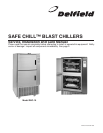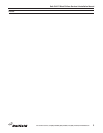
Safe Chill™ Blast Chillers Service & Installation Manual
3
For customer service, call (800) 733-8829, (800) 733-8821, Fax (989) 773-3210, www.deleld.com
Stabilizing
All models are supplied on casters for your convenience, ease
of cleaning and mobility. It is very important, however, that the
cabinet be installed in a stable condition with the front wheels
locked while in use.
Should it become necessary to lay the unit on
its side or back for any reason, allow at least 24
hours before start-up so as to allow compressor
oil to ow back to the sump.
Electrical Connection
Refer to the amperage data on page 2, the serial tag, your
local code or the National Electrical Code to be sure the unit is
connected to the proper power source. A protected circuit of the
correct voltage and amperage must be run for connection of the
line cord, or permanent connection to the unit.
The unit should be disconnected from the
power source whenever performing service,
maintenance functions or cleaning the
refrigerated area.
Be careful - the line cord is not run over by the
casters when moving the unit. This can damage
the cord.
Installation
Location
Be sure the location chosen has a oor strong enough to
support the total weight of the cabinet and contents. Reinforce
the oor if necessary to provide for maximum loading.
For the most efcient operation, be sure to provide good air
circulation inside and out.
Inside cabinet: Do not pack the equipment so full that air cannot
circulate.
Outside cabinet: Be sure that the unit has access to ample air.
Avoid hot corners and locations near stoves and ovens.
Installation note: Evaporator drains are also located to the right
of the evaporator housing and run to a condensate evaporator
pan. No external drains are needed as this is all self contained.
Drain lines need to be kept free from obstruction to allow for
proper water removal.
It is recommended that the unit be installed no closer than 2”
from any wall.
Leveling
A level cabinet looks better and will perform more efciently
when the doors line up with the door frames properly, the
cabinet will not be subject to undue strain, and the corners of
the shelves will not move around on the supports. Use a level to
make sure the unit is level from front to back and side to side.
The unit comes standard with non adjustable casters, a level
oor is very important. If it becomes necessary to level the unit
adjustable legs are available.
Operation Information
(SEE PAGE 4 FOR DIAGRAM OF CONTROL PANEL)
Operating Pressures
Normal operating pressures should be achieved during
the preservation mode, with approximately 75 of ambient
temperature. Freezer mode 15# suction and 220# discharge.
Chilling mode 55# suction and 220# discharge.
Blast Chilling (soft mode): This mode pulls the food down from
the starting temperature to food set point of 37˚F (FP1). Once
the temperature is obtained the unit sounds an alarm and either
switches to preservation mode automatically (after the alarm
times out) or manually. During pull down in soft mode, the blast
chiller maintains a box temperature of 23˚F (BT1). This mode is
primarily used for pulling down delicate foods.
Blast Chilling (hard mode): This mode operates the same way
as the soft mode except for the box temperature. During pull
down from start until one of the two food probes reaches 47˚F
(FP2) the box temperature is maintained at -5˚F (BT2), after
this point the box temperature is held at 23˚F (BT1) until the
food reaches 37˚F (FP1). This mode is for items that are harder
to pull down or if a faster chilling time is desired.
Blast Chilling (timed mode): This mode operates in either a
soft or hard mode. The user can preset the amount of time the
chiller pulls down for up to 240 minutes (TC1). The unit will
pull down until the time is reached or the two probes hit 37˚F
(FP1). At this point the unit will sound an alarm and go into
preservation mode.
Freezer Mode: This mode pulls the food down from starting
point to 0˚F (FP3). In this mode the unit operates in a hard chill
mode until one of the two food probes reach 37˚F (FP1). At that
point the box temperature is pulled down to -25˚F (BT3) until the
food set point of 0˚F (FP3) is reached. At this point an alarm is
sounded and the unit can go into preservation mode.
Preservation Mode: After any of the above cycles reach their
set point, the unit will go into a preservation mode. This mode
will be held until the user terminates it. After chilling, the
food probes will maintain a temperature of 37˚F (FP1) using
a box temperature of 23˚F (BT1). After the freezing, the food
probes will maintain a temperature of 0˚F (FP3) using a box
temperature of -15˚F (BT3).
continued pg. 4














